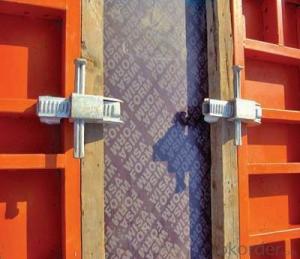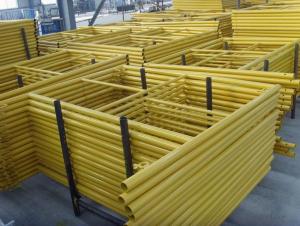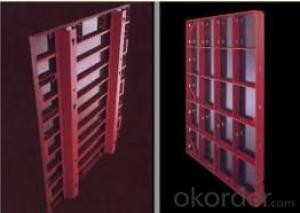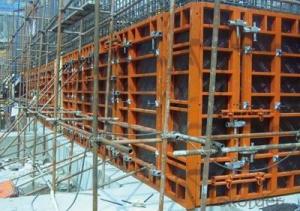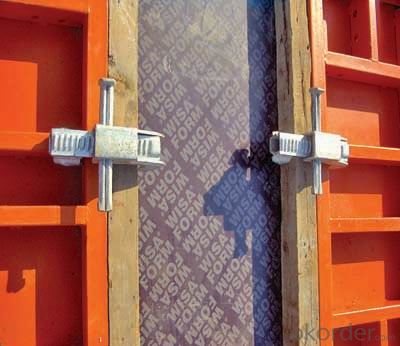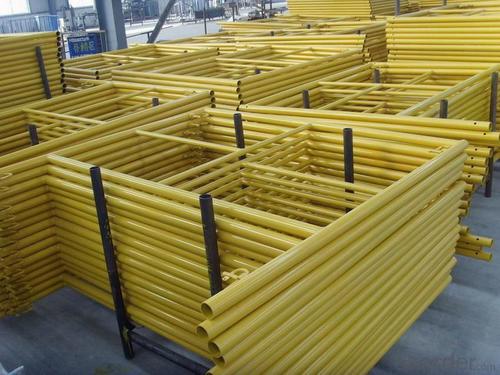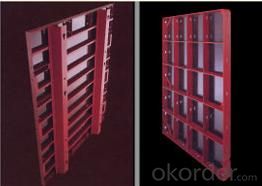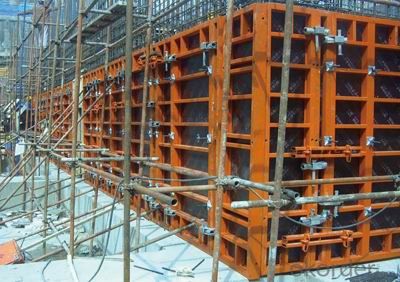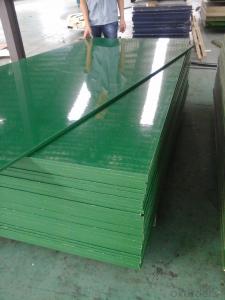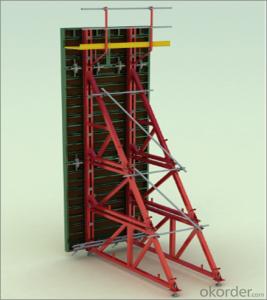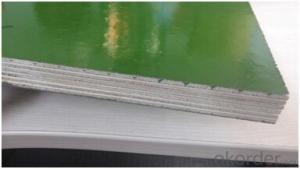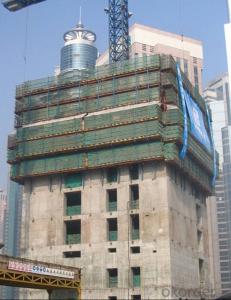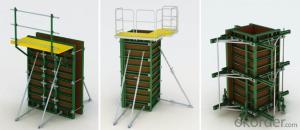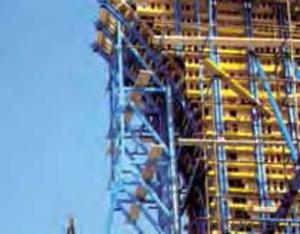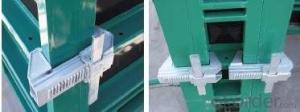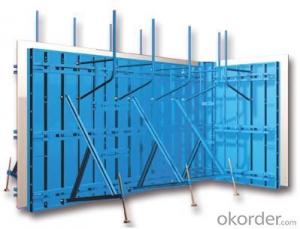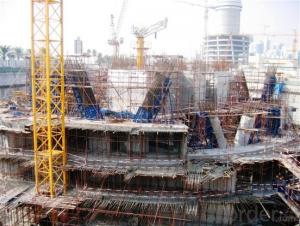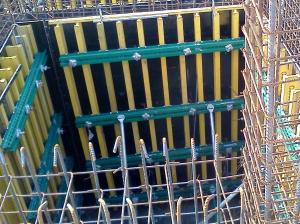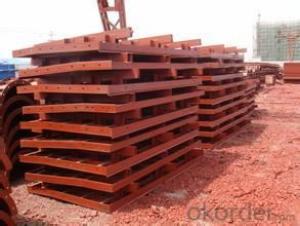Steel Frame Formwork with High Quality and Strong Strength in Building Industry
- Loading Port:
- Shanghai
- Payment Terms:
- TT OR LC
- Min Order Qty:
- 1 m²
- Supply Capability:
- 100000000 m²/month
OKorder Service Pledge
OKorder Financial Service
You Might Also Like
1. Structure of Steel Frame Formwork GK120
There is a prizing part designed in the corner, which can help to position and remove formwork easily.
The plywood is screwed on from the back when connecting frame and plywood, so the surface of the finished concrete is perfect.
The formwork series are a complete system with a full set of accessories, and can be set up flexibly according to project demand.
2. Main Features of Steel Frame Formwork GK120
High strength
High standardized system
Convenient for construction
Easy to control the quality
Easy, rapid and economical.
3. Steel Frame Formwork GK120 Images
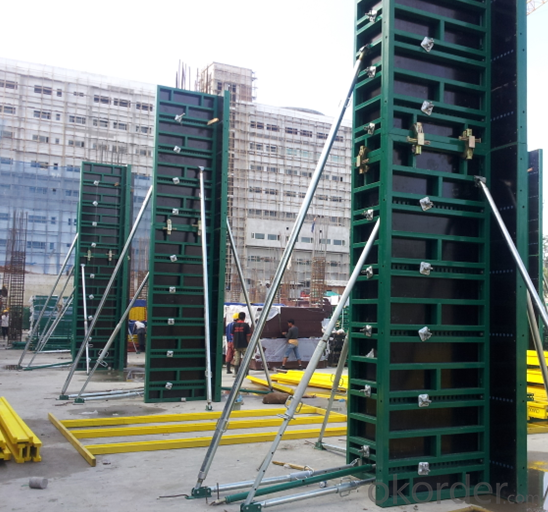
4. Steel Frame Formwork GK120 Specification
-Steel Frame Formwork GK120 is used for the concrete pouring of square or rectangle column. The system has the same structure and similar connection type with wall formwork.
-The frame is highly strengthened, and the wall formwork can bear lateral pressure 60 KN/m2 while the column formwork can bear 80 KN/m2.
-As a standardized system, it is flexible to assemble , wood batten can be filled to satisfy the need f of non-standard size.
-The plywood is screwed on from the back when connecting frame and plywood, so the surface of the finished concrete is perfect.
5. FAQ of Steel Frame Formwork GK120
1) What can we do for you?
.We can ensure the quality of the vinyl banner and avoid extra expenses for customers.
.We can provide you the professional design team.
.We can provide fashionable and newest styles for you.
2) What promises can be done by us?
. If interested in Steel Frame Formwork GK120, please feel free to write us for any QUOTE.
. Please DO check goods when courier knocks your door and contact us asap if any issue.
3) What about of our after-sale service?
. Response will be carried out in 24hours after receiving any complain or request.
. Steel Frame Formwork GK120 cost can be refund after order is confirmed.
4) What about the package and shipping time?
.Packing: As Customer's Requirements
.Shipping: We have various shipping ways for our customers, such as express which including TNT, DHL, FEDEX, UPS, EMS, etc. ; by air/ sea, and we are VIP of these express.
.Shipping time:
Normally small orders, it just 10-15 business days to arrive your hand; When comes to the customs declaration, it may need 7 days.
- Q: Can steel frame formwork be used in seismic areas?
- Yes, steel frame formwork can be used in seismic areas. Steel is a strong and durable material that can withstand the forces exerted during seismic events. However, it is important to ensure that the steel frame formwork is designed and installed properly, taking into consideration the specific requirements and regulations for seismic areas, to ensure its effectiveness and safety.
- Q: Can steel frame formwork be used for both concrete walls and slabs?
- Yes, steel frame formwork can be used for both concrete walls and slabs. The steel frame provides stability and strength, making it suitable for various types of concrete structures.
- Q: What are the requirements for the installation and the characteristics of the chimney sliding formwork
- Safety: to have enough strength, stiffness and stability, to ensure that the construction of no deformation, no damage, no collapse
- Q: What are the key considerations for selecting the appropriate steel frame formwork system?
- There are several important factors to consider when choosing the right steel frame formwork system: 1. Structural Requirements: It is essential to ensure that the chosen system can handle the load and stresses imposed by the concrete, while maintaining the overall structural integrity. 2. Formwork Design: The design of the formwork should align with the project requirements, considering the shape, size, and complexity of the concrete elements that need to be formed. 3. Durability and Longevity: The longevity and durability of the system are crucial, as they directly affect the project's cost-effectiveness. It should be able to withstand repeated use and exposure to different environmental conditions without significant deterioration. 4. Ease of Assembly and Disassembly: The system should be designed for quick and efficient installation and removal, reducing construction time and labor costs. 5. Safety: Safety is of utmost importance, and the system should be designed with adequate safety features to protect workers during installation and usage. 6. Cost: Cost-effectiveness is always a major consideration, taking into account initial investment, maintenance costs, and the overall lifespan of the system. 7. Availability and Support: It is important to consider the availability of the system and the support provided by the manufacturer or supplier, including technical assistance and guidance throughout the project. To conclude, selecting the right steel frame formwork system requires careful evaluation of factors such as structural requirements, formwork design, durability, ease of assembly, safety, cost, availability, and support. By considering these aspects, one can choose a system that best suits the project's needs and ensures successful construction.
- Q: How does steel frame formwork handle the placement of signage and wayfinding elements within the concrete structure?
- Steel frame formwork is a versatile and efficient system for constructing concrete structures, including the placement of signage and wayfinding elements within the structure. The steel frame provides a sturdy and reliable framework that can easily accommodate the installation of these elements. When it comes to signage, steel frame formwork allows for precise positioning and secure attachment of signs within the concrete structure. By incorporating designated areas or recesses into the formwork design, the signage can be seamlessly integrated into the concrete surface. This ensures that the signs are securely fixed and will not be easily dislodged or damaged. Furthermore, the steel frame formwork system allows for flexibility in the design and placement of signage and wayfinding elements. The formwork can be customized to accommodate various sizes, shapes, and types of signage, providing the freedom to create visually appealing and informative structures. Whether it is large directional signs, small informational plaques, or even 3D elements, the steel frame formwork can be tailored to meet the specific requirements of the project. Additionally, steel frame formwork enables efficient installation of signage and wayfinding elements. The formwork system is designed for easy assembly and disassembly, allowing for quick and accurate placement of the signs during the construction process. This reduces installation time and costs, ensuring that the project stays on schedule. Overall, steel frame formwork provides a reliable and adaptable solution for handling the placement of signage and wayfinding elements within a concrete structure. Its strength, flexibility, and ease of installation make it an ideal choice for incorporating these elements into architectural designs, ensuring that they are securely and aesthetically integrated into the structure.
- Q: What are the recommended maximum heights for steel frame formwork systems?
- The recommended maximum heights for steel frame formwork systems can vary depending on factors such as the design, load capacity, and safety regulations. However, it is generally advised to consult the manufacturer's guidelines and engineering experts to determine the specific maximum heights for a particular steel frame formwork system.
- Q: How does steel frame formwork contribute to the overall versatility of a construction project?
- Steel frame formwork contributes to the overall versatility of a construction project by providing a highly adaptable and reusable system for creating concrete structures. Its modular design allows for easy assembly and disassembly, enabling quick adjustments or changes to the formwork layout. Additionally, the strength and durability of steel make it capable of supporting large concrete loads and withstanding harsh construction conditions. This versatility allows for the construction of various types of structures, shapes, and sizes, making steel frame formwork an essential tool in modern construction projects.
- Q: Can steel frame formwork be used in projects with restricted construction budgets?
- Yes, steel frame formwork can be used in projects with restricted construction budgets. While steel frame formwork may initially have a higher upfront cost compared to other formwork materials, it offers several advantages that can result in cost savings in the long run. Steel formwork is highly durable, reusable, and requires less maintenance, reducing the need for frequent replacements or repairs. Additionally, it provides a smooth and accurate finish, minimizing the need for additional finishing work, thus saving both time and money. Overall, the cost-effectiveness and long-term benefits of steel frame formwork make it a viable option for projects with restricted construction budgets.
- Q: How does steel frame formwork handle the placement of concrete in vertical or inclined structures?
- Steel frame formwork is a versatile and efficient system utilized for placing concrete in vertical or inclined structures, offering numerous advantages compared to traditional formwork systems. This has made it the preferred option for many construction projects. One of the standout features of steel frame formwork is its ability to effortlessly handle concrete placement in vertical or inclined structures. The steel frames are designed to be robust and rigid, providing exceptional support and stability throughout the pouring and curing process. This ensures proper containment of the concrete, preventing leaks or spills and resulting in a high-quality end product. Furthermore, the steel frames are adjustable, enabling precise positioning and alignment of the formwork in vertical or inclined structures. This is particularly crucial when dealing with intricate architectural designs or irregular shapes. The flexibility of the steel frames allows contractors to create tailor-made formwork solutions that meet the specific requirements of each project. Additionally, steel frame formwork is both reusable and durable, making it a cost-effective solution for multiple construction projects. Once the concrete has cured and the formwork is removed, the steel frames can be easily cleaned and prepared for future use. This not only saves time and money but also reduces waste and promotes sustainability within the construction industry. Moreover, steel frame formwork can be swiftly assembled and disassembled, making it a practical choice for projects with tight timelines or limited space. The system's modular design facilitates quick installation and efficient workflow, ensuring that the concrete placement process is completed on schedule. To conclude, steel frame formwork is a dependable and efficient solution for handling concrete placement in vertical or inclined structures. Its strength, adjustability, reusability, and ease of assembly make it an ideal choice for construction projects of all sizes and complexities.
- Q: How does steel frame formwork handle the placement of MEP (mechanical, electrical, plumbing) systems within the concrete structure?
- Steel frame formwork provides a reliable and flexible solution for the placement of MEP systems within a concrete structure. The formwork system allows for precise and accurate positioning of MEP components, such as pipes, conduit, and ductwork, as it provides clear and accessible spaces for their installation. Additionally, the steel frame formwork can be easily adjusted or modified if any changes or additions to the MEP systems are required during the construction process, ensuring efficient integration of these systems within the concrete structure.
Send your message to us
Steel Frame Formwork with High Quality and Strong Strength in Building Industry
- Loading Port:
- Shanghai
- Payment Terms:
- TT OR LC
- Min Order Qty:
- 1 m²
- Supply Capability:
- 100000000 m²/month
OKorder Service Pledge
OKorder Financial Service
Similar products
Hot products
Hot Searches
